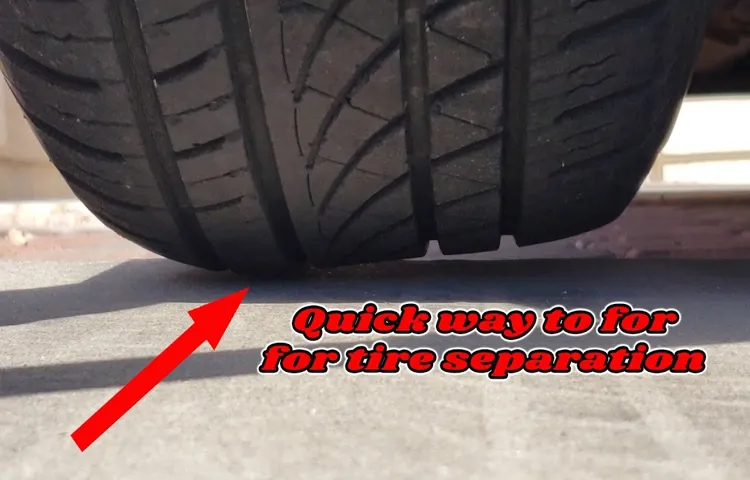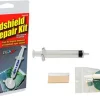Have you ever experienced a tire separation while driving? It’s a scary situation that can happen to anyone at any time. Tire separation occurs when the tread separates from the tire, leading to loss of control, swerving, and possibly even a crash. There are several factors that can cause tire separation, including poor tire maintenance, overloading, and manufacturing defects.
But don’t worry, there are also steps you can take to prevent tire separation and stay safe on the road. In this blog, we’ll explore the causes of tire separation, how to prevent it, and what to do if it happens to you. Let’s get started!
Table of Contents
Introduction
If you’ve ever been stranded on the side of the road with a blown-out tire, you know just how frustrating and inconvenient it can be. One of the causes of tire blowouts is tire separation, which occurs when the different layers of the tire start to come apart from one another. There are several factors that can contribute to tire separation, including overloading your vehicle, underinflated or overinflated tires, poor tire maintenance, and even driving on rough or uneven terrain.
Over time, the heat generated by friction as you drive can also cause the different layers of rubber and steel inside your tires to start to separate. To avoid tire separation and blowouts, it’s important to keep your tires properly inflated, drive cautiously, have your tires rotated and balanced regularly, and replace your tires when necessary. By taking these simple steps, you can ensure that your tires will stay in good condition and reduce your risk of a dangerous blowout on the road.
What is Tire Separation?
Tire separation is a serious issue that can cause accidents and damage to your vehicle. In simplest terms, tire separation occurs when the tire tread detaches from the tire carcass, resulting in a loss of control over the vehicle. This can lead to accidents, rollovers, and other dangerous situations.
The main causes of tire separation are improper maintenance, overloading, and excessive speed. When driving, it is important to pay attention to your tires and have them checked regularly by a professional. Doing so can prevent tire separation and ensure your safety on the road.
Remember, prevention is always better than cure, so make sure to take care of your tires before it’s too late.

Causes of Tire Separation
Tire separation occurs when the tire’s steel belts and the rubber tread separate from each other, causing the tire to fail. There are various reasons why a tire can separate, including age, overloading, underinflation, and manufacturing defects. Tires gradually age, and as they do, the rubber breaks down and becomes brittle, making it more likely to separate.
Overloading a tire puts it under immense pressure, causing the rubber and steel belts to deform and heat up, eventually leading to a separation. Underinflated tires bend and flex more than properly inflated ones, causing the rubber and steel belts to break apart. Lastly, manufacturing defects like faulty bonding or under-cure of the rubber can result in an issue.
Regular tire maintenance and inspection can help detect these causes and prevent tire separation.
1. Overheating
One of the top reasons for tire separation is overheating. When a tire overheats, the internal structure of the tire is damaged, which can lead to a separation. Overheating can occur due to various reasons, including prolonged driving at high speeds, overloading the vehicle, or sharp braking.
It is important to ensure that your tires are inflated at the recommended level to avoid overheating. Additionally, you should regularly monitor the condition of your tires, looking for signs of uneven wear, bulges, or cracks, which are indications of tire separation. If you notice any of these signs, it is essential to replace the tire immediately to avoid a potential accident.
Overall, taking preventative measures and keeping an eye on your tires can help you avoid tire separation caused by overheating.
2. Underinflation
One of the primary causes of tire separation is underinflation. When tires are underinflated, they create uneven pressure on the tire’s sidewall. This can lead to excessive heat buildup, which can cause the tire to degrade and eventually separate.
Underinflated tires also increase the friction between the road and the tire, leading to further heat buildup. This can cause the tread to come off and the tire to fail completely. It’s important to monitor your tire pressure regularly and inflate them to the recommended levels to avoid the dangers of tire separation.
Neglecting this can have dangerous consequences and can put you and your passengers at risk of an accident. So, don’t forget to keep an eye on your tire pressure and make sure it’s always at the recommended level. It’s a small but essential step to ensure your safety on the road.
3. Overloading
When it comes to tire separation, overloading a vehicle is a major cause of this issue. Overloading tires beyond their capacity puts undue stress on them, causing them to overheat and ultimately separate. It’s important to note that each vehicle has a specific weight limitation that drivers must adhere to.
When exceeding these limits, it increases the likelihood of tire separation and also increases the risk of accidents on the road. It’s essential that drivers are aware of the weight limitations and make sure to properly distribute the load. Otherwise, they are jeopardizing their safety and the safety of others on the road.
Remember, overloading your vehicle not only damages your tires but puts you at risk of legal consequences as well. Keep your loads within the weight limitations and enjoy safer and smoother rides.
4. Poor Maintenance
One of the key causes of tire separation is poor maintenance. This is usually overlooked or ignored, but it can have serious consequences over time. Defective or damaged tires that have not been checked or repaired can lead to tire separation, which can cause accidents and even fatalities.
It is essential to conduct regular tire inspections, check for any signs of wear and tear, and promptly replace any damaged or worn-out tires. Proper tire pressure, alignment, and rotation are also vital to prevent tire separation. Neglecting these simple maintenance procedures can significantly increase the risk of tire failure and put you and other drivers on the road at risk.
Remember, investing in regular tire maintenance is a small price to pay to ensure your safety and that of others on the road.
5. Manufacturer Defects
One of the reasons for tire separation is manufacturer defects. When a tire is manufactured, certain defects can occur that weaken its structure, causing it to separate eventually. Such defects can result from a faulty design, manufacturing process, or poor quality materials used during production.
Even minor errors can lead to significant consequences, causing the tire to blow out while in use, posing a serious threat to the driver and passengers. That is why it’s crucial to choose reliable tire manufacturers with a good reputation for producing high-quality, safe products. By doing so, you can reduce the risk of tire separation and ensure a smoother, safer driving experience.
Remember, safety should always come first when it comes to choosing the right set of tires for your vehicle.
Preventing Tire Separation
Tire separation can be a scary experience for any driver as it can lead to unexpected accidents and even fatalities. It occurs when the layers of rubber and cords inside a tire break apart, causing the tire to literally come apart at the seams. One of the main causes of tire separation is heat buildup, which weakens the rubber and fibers over time.
This results in a weaker tire that is more likely to separate during use. Other factors that can lead to tire separation include overloading a vehicle, low tire pressure, poor maintenance, and road hazards such as potholes and debris. To prevent tire separation, it is important to regularly check tire pressure, avoid overloading the vehicle, and get regular tire maintenance checkups.
Additionally, it is important to avoid driving on damaged or poorly maintained roads as they can increase the risk of tire damage. By taking these precautions, drivers can reduce their risk of experiencing a dangerous and potentially deadly tire separation event.
1. Proper Inflation
Proper inflation is crucial in preventing tire separation and ensuring the safety of your vehicle on the road. It’s important to follow the manufacturer’s recommended tire pressure, which can be found in the owner’s manual or on a label inside the driver’s door. Underinflation increases the risk of tire failure, as it causes the sidewalls to flex more and generate more heat.
On the other hand, overinflation can cause the center portion of the tire tread to wear out quickly and decrease traction. Checking tire pressure regularly can also improve fuel efficiency and prolong the life of your tires. Remember, maintaining proper inflation is a simple task that can help you avoid costly repairs and accidents on the road.
2. Regular Maintenance
Regular maintenance of your vehicle is crucial when it comes to ensuring its longevity and safety. One aspect of maintenance that is often overlooked is preventing tire separation. Tire separation occurs when the different layers of the tire start to separate from each other, resulting in a dangerous and potentially fatal blowout on the road.
To prevent tire separation, it is important to regularly check your tires for signs of wear and tear, such as cracks or bulges. It is also essential to have your tires rotated and balanced regularly to ensure even wear and tear. Additionally, properly inflating your tires to the recommended pressure can also help prevent tire separation.
By staying on top of maintenance and keeping a close eye on the condition of your tires, you can minimize the risk of tire separation and ensure a safer driving experience. So, don’t neglect your tires and make sure to give them the care they deserve to avoid any costly or dangerous problems down the road.
3. Load Capacity Adherence
When it comes to preventing tire separation, one key factor to consider is load capacity adherence. Overloading your vehicle beyond what your tires are rated to handle can lead to serious problems, such as tire blowouts and even accidents. It is important to ensure that your tires have the proper load-carrying capacity for the weight of your vehicle and any cargo it may be carrying.
This information can usually be found in your vehicle’s owner’s manual or on the tire itself. Additionally, it’s important to regularly inspect your tires for signs of wear and tear, such as cracks or bulges, and replace them when necessary. By following these simple tips, you can help prevent tire separation and keep yourself and others safe on the road.
4. Quality Tires
As a car owner, it’s essential to take good care of your vehicle and always ensure that your tires are in good condition. One of the most critical aspects of tire maintenance is preventing tire separation. Tire separation is a dangerous phenomenon that occurs when the bond between the tire’s layers weakens, causing the tire to lose its form and eventually burst.
However, one way to prevent tire separation is by investing in quality tires. Good quality tires are reliable, durable, and can handle various road conditions, reducing the chances of tire separation. You may have to pay extra to acquire high-quality tires, but it’s worth it because it can prevent accidents caused by tire failure.
It’s crucial to remember that your tires are the only thing connecting your vehicle to the road, so investing in quality tires is investing in your safety. Ultimately, correctly maintaining your tires and adequately inflating them can prevent tire separation and keep you safe on the road.
Conclusion
In conclusion, just like a relationship gone bad, a tire separation happens when the bond between the rubber and the steel belts breaks down. Whether it’s due to heat, overloading, or just plain neglect, a separation is a reminder that we should always keep a close eye on our tires and give them the love and attention they deserve. Otherwise, we might find ourselves stranded on the side of the road, looking for a new ride and a fresh start.
“
FAQs
What is tire separation?
Tire separation is when the tire tread separates from the tire carcass, causing the tire to fail.
What causes tire separation?
Tire separation can be caused by a variety of factors, including improper inflation, overloading, worn or damaged tires, and excessive heat buildup.
How can overloading cause tire separation?
Overloading can cause tire separation by placing too much stress on the tire, causing it to overheat and break down.
Can tire age contribute to tire separation?
Yes, tire age can be a factor in tire separation. As a tire gets older, it can become more prone to cracking and other forms of damage that can lead to separation.
How can I prevent tire separation?
To prevent tire separation, make sure to regularly inspect your tires for signs of wear or damage, maintain proper inflation levels, and avoid overloading your vehicle.
What should I do if I experience tire separation while driving?
If you experience tire separation while driving, try to keep control of your vehicle and safely pull over to the side of the road. Do not continue driving on a separated tire.
Is tire separation covered by warranty?
Tire separation may be covered by a manufacturer’s warranty, depending on the circumstances of the separation and the age of the tire. Check with your tire manufacturer for more information.



